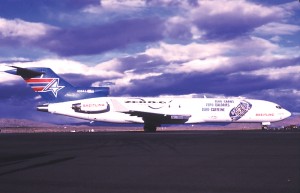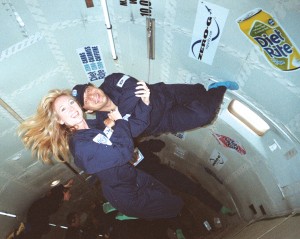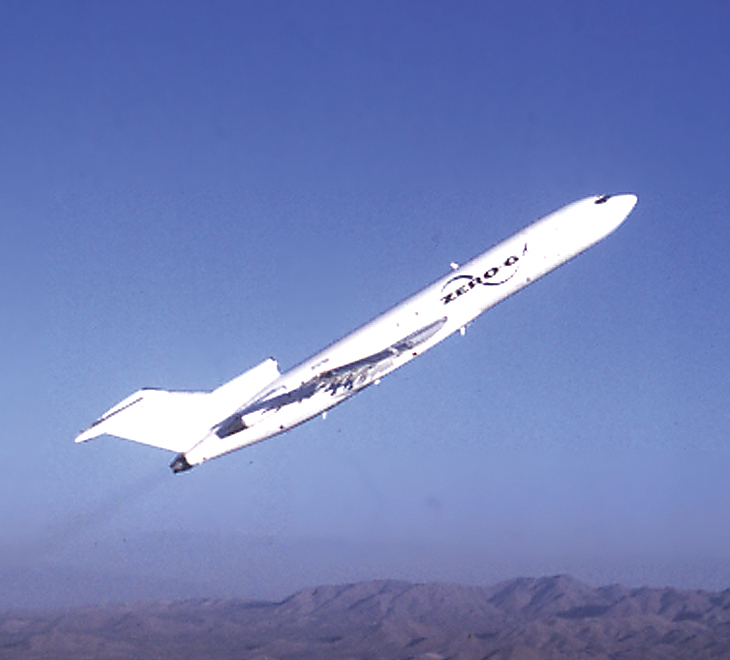By Bob Shane

Zero-G selected the Boeing 727-200 to provide its weightless flight service. Early flight test evaluations were conducted back in December 1999 using this B-727. Here the 727 is climbing at a 45-degree angle of attack, in the ascent phase of the parabola.
How can one feel like they’re floating in outer space without really going there? The answer is to buy a $2,950 ticket on G-Force One, a specially modified B-727-200 that simulates the weightless condition of space by flying parabolic trajectories within a designated piece of sky four miles above the Gulf of Mexico. Operating between 22,000 and 32,000 feet, it’s the world’s highest roller coaster ride. The parabolic flight patterns counteract the earth’s gravity producing a weightless condition inside the aircraft, which lasts up to 25 seconds.
Inside this civilian version of NASA’s “Vomit Comet,” keeping one’s cookies under control could be a challenge. Even astronauts with a proven reputation for having the “right stuff” have felt the need to use their airsick bag. Despite the possibility of a brief moment of discomfort, everyone returning from a flight on G-Force One seems to deplane with a big smile on their face. Lisa Blazek, a working housewife and mother of three from Houston, who recently took a Zero-G flight, jokingly stated, “I would eat peanut butter and jelly sandwiches for a year to be able to save up the money to do it again.”
Perseverance pays off
Dr. Peter Diamandis has his eye on the stars and if he has his way, he’d like to travel there and take all of us with him. He’s a man on a mission—a space mission. As the cofounder, chairman and CEO of Zero Gravity Corporation, the world’s first and only Federal Aviation Administration-approved commercial provider of weightless flight, Diamandis is the driving force behind a movement to make space-related experiences accessible to the general public.
With the launch of Zero-G, the average person can now experience weightlessness—a sensation once limited to researchers and astronauts in training—first hand.
Diamandis holds an undergraduate and graduate degree in aerospace engineering from the Massachusetts Institute of Technology and has an MD from Harvard Medical School. A space industry veteran, he has served as the chairman of Students for the Exploration and Development of Space and founded the International Space University. He’s the chairman of the X-Prize Foundation, which just awarded $10,000,000 to Burt Rutan and Scaled Composites for building the first publicly funded three-passenger rocket plane to successfully penetrate outer space and return to earth, twice within two weeks.
In an interview with Airport Journals, Diamandis outlined what he foresees as a possible timetable for John Q. Public’s progressive intervention into outer space. In the next two to four years, he envisions his zero gravity ride, which he calls a “high quality fun experience,” will become common place. In the next three to five years, sub-orbital flight will become available, followed by orbital flights in 2010.
“When reliable commercial flights into orbit are achieved, you’re close to going to the moon, since you will already be two-thirds of the way there,” Diamandis said.
Then you will see attempts by private individuals to land on the moon, followed by the establishment of outposts and space hotels. The Zero-G experience is but a prelude to the total commercialization of this vast frontier we call outer space.
Since the founding of the Zero Gravity Corporation in 1993, Diamandis and Co-founder Byron Lichtenberg, a former NASA payload specialist/astronaut and Zero-G’s president and chief astronaut, have spent the last 11 years working on their dream to make it possible for the public to be able to enjoy the experience of weightless flight. The past five years were spent working closely with the FAA to perform the requisite engineering, aircraft modification and flight-testing needed to secure FAA certification. More than one thousand parabolas were conducted during the flight-test phase. Since it was the first commercial operation of its kind, the testing was extensive.
G-Force One
Following a comprehensive analysis, the airplane Zero-G selected for its parabolic flight service was the Boeing 727-200 cargo aircraft. Its centrally mounted engines, T-tail and compliance with FAA noise abatement standards provided optimum flight characteristics for the smooth and stable performance of parabolic flight patterns.
The most significant modification to the aircraft was an upgrade to its hydraulic system. This was necessary to assure that continuous hydraulic pressure is maintained during the parabolic maneuver. Accelerometers were also added to the cockpit instrumentation.
The 727 has a large cargo door and a built-in pallet system making it easy to change the interior configuration. The cabin is divided into two main zones. The aft area is the seating zone, where airliner style seats can accommodate up to 30 passengers and crew. The forward section is the floating zone. It’s nearly 70 feet long with padding on the floor, walls and ceiling. The floor is covered with a special FAA-approved energy absorbing material called Ensolite.
The aircraft is leased from Amerijet International, a cargo airline based in Fort Lauderdale. Flights operate under Part 121 of the Federal Air Regulations. These are the same rules that govern commercial airline passenger operations. The parabolic maneuvers required are reportedly well within the Boeing 727’s safe operating limits.
Expanding the entertainment envelope

Amerijet International, a cargo operator based in Fort Lauderdale, is Zero-G’s current aircraft partner. The B-727 used to provide weightless rides is shown at Reno Stead Airport, after picking up a group of flyers.
Zero-G officially started selling rides to the public on Sept. 14, 2004. Diet Rite, a division of Dr. Pepper/Seven Up Inc., is the official launch sponsor. It’s also the official drink of Zero-G. A giant Diet Rite Cola logo is emblazoned on the side of the G-Force One 727.
The advertisement publicizes the drink’s “Zero-Carbs, Zero-Calories and Zero-Caffeine.” The soda producer made the first promotional tour with the aircraft, giving rides to bottlers, journalists and winners of radio show contestants in six different cities.
One market segment that has shown substantial interest in the weightless flights are companies that book employee incentive awards. The Zero Gravity Experience offers a new and unique alternative to what typically has been just another conventional golf tournament.
The movie industry has also shown a significant interest in using G-Force One for filming weightless scenes. The blockbuster movie “The Matrix” had scenes that were shot in the Zero-G environment.
A weightless flight to nowhere
The Zero-G Experience is a full-day program. The ground portion is conducted at the Seminole Hard Rock Casino in Hollywood, Fla. After registration, every “flyer” (the customer) dons a blue flight suit. Each Zero-G flight will accommodate up to 27 flyers, a flight attendant, flight director, a veteran astronaut, three coaches and the standard three-person flight crew. Following the mission briefing and astronaut presentation, the 27 flyers are divided into three groups. After the groups meet with their coach, everyone is transported by bus to the Fort Lauderdale/Hollywood International Airport, where they board the B-727 aircraft for a two-hour flight.
After departure, it takes 30 minutes for G-Force One to reach the designated area above the Gulf of Mexico. It’s an invisible parabolic box, 100 miles long and 10,000 feet deep. Flying along at the bottom of the box (22,000 feet), the 727 starts its ascent at a 45-degree angle of attack. Climbing to 32,000 (the top of the arc), the aircraft changes attitude and goes into a 30-degree descent. At the top of the arc, the flyers experience a weightless state, floating, tumbling and bouncing off the ceiling, walls and floor. In total, the 727 does a series of 15 weightless maneuvers. Each flyer gets to experience what it’s like to walk on Mars at one-third gravity, the Moon at one-sixth gravity and the weightlessness of space. There are six video cameras continuously taping the cabin action during each weightless session. A copy of this recording is given to each flyer as a memento.
Once the flight portion of the program has been completed, G-Force One returns to Fort Lauderdale Airport. Everyone then travels by bus back to the casino for the “Re-Gravitation Party.” Each flyer is given a certificate signifying that they are now “Weightless Certified,” having taken the Zero-G Experience.
Bill House, a 76-year-old thrill seeker from Baton Rouge, La., took a Zero-G flight in November. House works as a computer consultant. In top shape, he does pushups every morning and works out at the Y. When asked why Zero-G, he said, “I like anything that gets my adrenaline going.”

A flyer and Dr. Peter Diamandis are experiencing the fun and adventure of weightless flight aboard “G-FORCE ONE.”
He’s done mock dog fighting with Fighter Combat, driven a Formula I race car at the Mario Andretti Driving School and holds a world’s record for being the oldest person to do a tandem Halo parachute jump. House said everyone should have the Zero-G Experience.
“It’s an experience not comparable to anything I’ve ever done before,” he said.
Husband and wife Blake and Lisa Blazek experienced Zero-G together. Lisa got Blake the ride as a present for him for his 50th birthday. When a friend of the family who was also scheduled to take the ride couldn’t make it, Lisa took his place and had the time of her life.
“It’s the most unique and awesome thing I’ve ever done,” she said of the experience. “You’re having so much fun you forget you’re on an airplane. It’s something everyone should do!”
With testimonials like that, it’s easy to see why Zero-G flights have proven to be more popular than anticipated. If you have a penchant for a unique and unusual adventure, G-Force One is the aircraft that will fly you there. But don’t delay in booking your ride; reservations on future weightless flights are now being booked at $3,750 per earthling.
For more information, visit [http://www.nogravity.com/].











